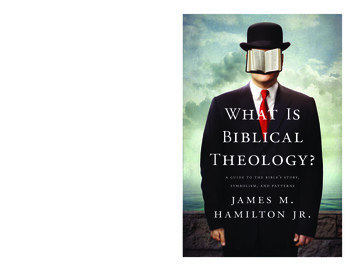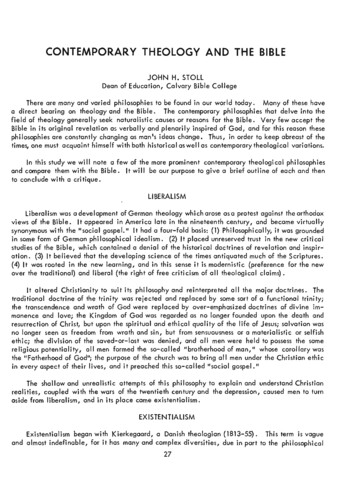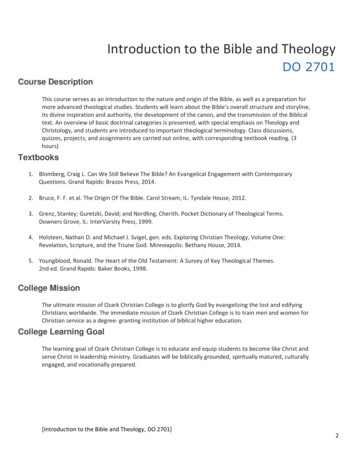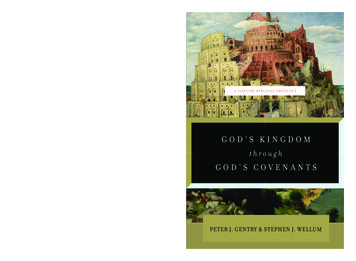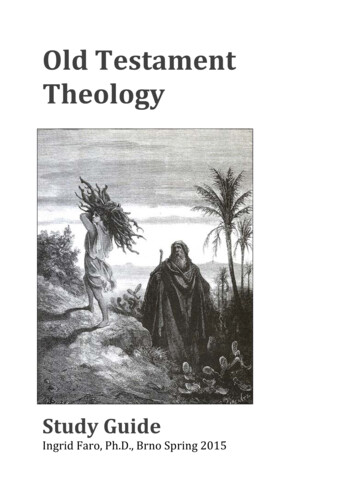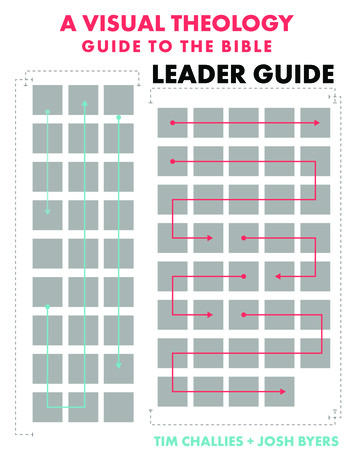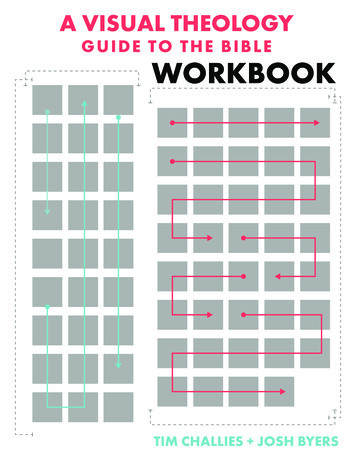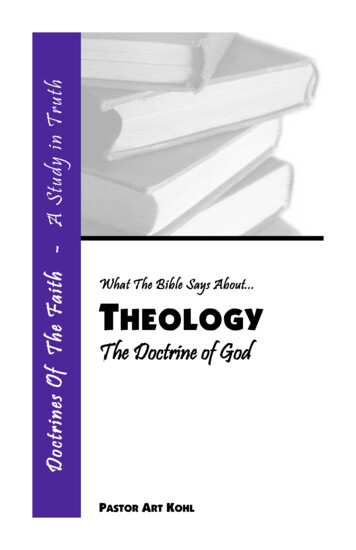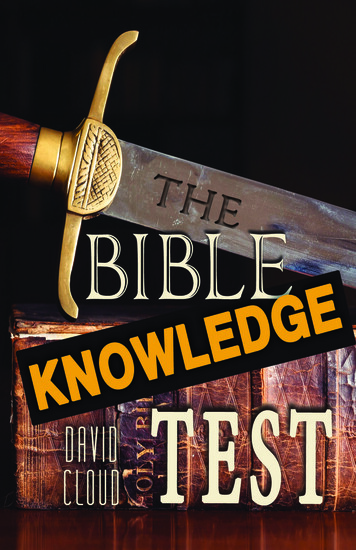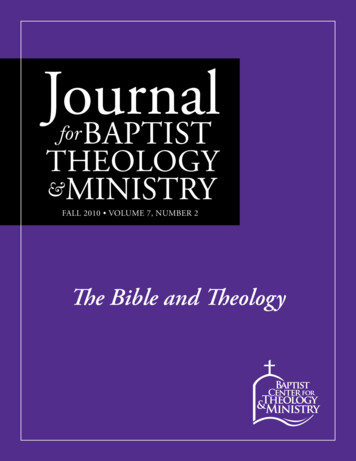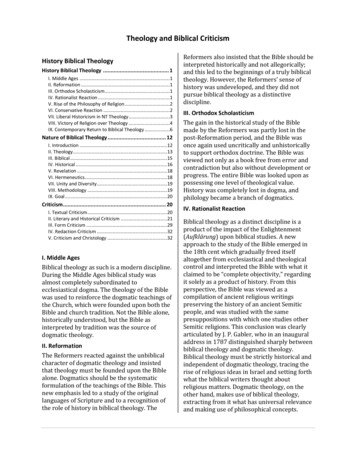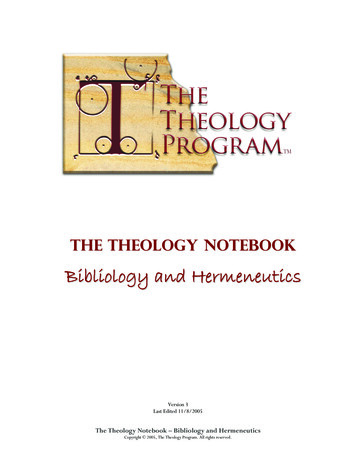
Transcription
The Theology NotebookBibliology and HermeneuticsVersion 3Last Edited 11/8/2005The Theology Notebook – Bibliology and HermeneuticsCopyright 2005, The Theology Program. All rights reserved.
iiCopyright 2002–2005 The Theology Program.Published by Biblical Studies Press, LLC, 11601 Plano Rd. Suite 108, Dallas, TX 75243.This material is provided for students and instructors in The Theology Program. Use of this material isencouraged for personal study and for use in preparation of lessons, sermons, or other oral communication.This material may be quoted so long as the material is unaltered and credit is given to The TheologyProgram. It may not under any circumstances be reprinted for any reason or any purpose without the priorexpressed written consent of the Biblical Studies Press.Certified instructors in The Theology Program are allowed to add to the material so long as approval isgranted by The Theology Program developers. Pastors and teachers are encouraged to use the material intheir teaching, but it must remain unaltered.Unless otherwise noted, Scriptures are taken from the NEW AMERICAN STANDARD BIBLE, Copyright The Lockman Foundation 1960, 1962, 1963, 1968, 1971, 1972,1973, 1975, 1977, 1995. Usedby permission. Scriptures are also taken from the NET Bible, 1997–2003 by Biblical Studies Press,L.L.C. and the authors, and from HOLY BIBLE, NEW INTERNATIONAL VERSION . Copyright 1973, 1978, 1984 by International Bible Society. Used by permission of Zondervan Publishing House.The Theology Notebook – Bibliology and HermeneuticsCopyright 2005, The Theology Program. All rights reserved.
Bibliology and Hermeneutics“Every scripture is inspired by God and useful for teaching, for reproof, for correction, and fortraining in righteousness, that the person dedicated to God may be capable and equipped forevery good work.”—2 Timothy 3:16–17Question Outline What is Tradition? What are the five main views ofauthority? Is Scripture all we need? What are the arguments for andagainst Sola Ecclesia? What are the arguments for solaScriptura? Do we have the right words? What is Textual Criticism? How accurate are the Old and NewTestaments? Do we have the right books? What are the facts concerning thecanon? What are the tests for canonicity? Should the Apocrypha be included inthe cannon? What was the development of theNew Testament? How do we know the Bible isinspired? What is the biblical view ofinspiration? What are the theories of inspiration? Where does inspiration lie? What is Biblical Docetism? How do we know the Bible isinspired? What internal and external evidenceis there for the Bible’s authenticity? Does the Bible err? How is inerrancy different frominfallibility? What is the Chicago Statement ofBiblical Inerrancy? What are examples of allegedbiblical contradictions? How have people historicallyinterpreted Scripture? How did the Jewish readersinterpret the Old Testament in Christ’sday? How did the New Testamentauthors interpret Scripture? How did the people interpret theBible in the “Dark Ages”? How did the Reformers interpretthe Bible? What is the modern way ofinterpreting the Bible? What are the principles of BiblicalInterpretation? What are examples of interpretationfallacies?The Theology Notebook – Bibliology and HermeneuticsCopyright 2005, The Theology Program. All rights reserved.
ivCourse OutlineCourse OutlineSyllabusSession 1:Session 2:Session 3:Session 4:Session 5:Session 6:Session 7:Session 8:Session 9:Session 10:Appendix 1:Appendix 2:Key Terms:. vClass Introduction and Authority . 1Sola Scriptura .21Transmission of Scripture.41Canonization of Scripture (OT) .53Canonization of Scripture (NT).69Inspiration .87Proving Inspiration .97Inerrancy. 117History of Interpretation . 127Historical-Grammatical Hermeneutics . 145The Chicago Statement on Inerrancy . 161The Chicago Statement on Biblical Hermeneutics. 173. 179The Theology Notebook – Bibliology and HermeneuticsCopyright 2005, The Theology Program. All rights reserved.
Bibliology and HermeneuticsSyllabusCourse DescriptionThis course focuses on the authority, nature, and interpretation (hermeneutics) ofthe Scriptures. It is designed to help students work through issues that concern thetrust they place in the Bible and its interpretation. We will compare the variousChristian traditions’ views of authority, examining the Reformation principle of solaScriptura. The Scripture will be studied as an ancient text focusing on its transmissionand canonization. We will also ask tough questions concerning the inspiration andinerrancy of Scripture. We will then look at how the Church has interpreted theScriptures throughout history, ending our time by looking at current trends inEvangelical hermeneutics.Course Objectives1. The student will understand the vital difference between the Protestantand Roman Catholic views of authority.2. The student will learn why we believe the Bible today essentially is thesame as when it was originally written.3. The student will learn why we believe that the Bible today has the rightbooks.4. The student will learn the different views of inspiration and inerrancy.5. The student will understand why we believe the Scriptures alone are theinspired word of God.6. The student will learn about historical-grammatical-literary hermeneutics.The Theology Notebook – Bibliology and HermeneuticsCopyright 2005, The Theology Program. All rights reserved.
viSyllabusCourse TextbooksRequired: Grudem, Wayne. Systematic Theology. Grand Rapids, MI: Zondervan,1994. Olson, Roger. Mosaic of Christian Beliefs. Downers Grove, IL: IVP, 2002. Bible (preferably New American Standard or NET Bible)Course Requirements and GradingThis course can be taken at two levels: Certificate or self-study.1. Certificate Students: Certificate students take the course for a grade toreceive a certificate that can be applied towards the TTP diploma. You mustpay the tuition, attend or view all ten sessions, and complete enough of thehomework according to the grading system below to receive a passing grade.This applies to both online and campus students.2. Self-study: Self-study students take the course for enrichment only.Homework is not required, although doing homework will obviously enrichyour learning from the course.Continuing Education Units (CEUs) may be offered depending upon the venue.Ask your instructor for more information.Honors credit can be earned in this course by completing all the coursework andcompleting an additional reading assigned by the teacher. See bibliography foroptions.Assignment Description - see course schedule for due datesViewing/Attending classes: Students are required to attend or view all tensessions of the course. (All sessions for every course are posted on the TTPwebsite and are available for viewing or for purchase.) Online certificateThe Theology Notebook – Bibliology and HermeneuticsCopyright 2005, The Theology Program. All rights reserved.
Syllabusviistudents: It is preferred that you view only one session per week so you won’t gettoo far ahead of the rest of the class. While attending or viewing the sessions isrequired for all certificate students, it does not apply toward your grade and youcannot receive credit without it.Ten hours of theological community time (online certificate studentsonly): All online certificate students are required to spend one hour a week in theonline TTP forums or in the voice/chat rooms provided. Each course will have aseparate classroom in the TTP forums. In this classroom, you can accruetheological community time by asking or answering questions of other students,blogging your thoughts, discussing issues relevant to the course, or posting youranswers to the discussion questions at the end of each lesson. Voice and chatrooms will be open each week where you can participate in live theologicalconversation with other students in your class (see website for details). Whiletheological community time is required for all online certificate students, it doesnot apply toward your grade and you cannot receive credit without it.1. Reading: Various reading assignments will be given during the ten-week period.Each student will be expected to read the material according to the ten-weeksession schedule provided in the syllabus.2. Scripture memorization: Each student will memorize the passages providedon the Scripture memorization sheet in the syllabus. Once completed, the studentwill recite the memorized Scripture to a partner who will affirm the completionby signing the Scripture memorization sheet.The preferred translations for all memorization in English are listed below: New American Standard NET Bible (available at www.bible.org) English Standard Version New International Version3. Case Studies: The two case studies in the Student Notebook must be completedaccording to schedule. Online certificate students are to post their case studiesonline on the TTP forums. Your instructor will grade them online, marking themin red.The Theology Notebook – Bibliology and HermeneuticsCopyright 2005, The Theology Program. All rights reserved.
viiiSyllabus4. Vocabulary Quizzes: Two closed-book theological vocabulary quizzes will begiven during the course of the semester. Online students can find these quizzes onthe website. See schedule for due dates. Once the student looks at the quiz, he orshe must take the quiz. In other words, you cannot look at the quiz, study theright terms, and then take the test.Grading SystemComplete 1 of 4Complete 2 of 4Complete 3 of 4Complete 4 of 4DCBAComplete all 4plus honorsreadingAwith honorsThe Theology Notebook – Bibliology and HermeneuticsCopyright 2005, The Theology Program. All rights reserved.
SyllabusixScheduleSessionNo.SessionDateSession TopicAssignments1Introduction andAuthority2Sola Scriptura3Transmission ofScriptureReading Assignment: Systematic Theology,pp. 54-724Canonization ofScripture (OT)Reading Assignment: Systematic Theology,pp. 73-89; Mosaic of Christian Belief, pp.89-109Case Study #1Vocabulary Quiz #156Canonization ofScripture (NT)Inspiration ofScriptureProving Inspiration7Reading Assignment: Systematic Theologypp. 127-138Session 2Session 3Session 4Session 5Session 6Session 7Reading Assignment: “Chicago Statementof Biblical Inerrancy” (Appendix 1 in theStudent notes); Systematic Theology, pp.90-1048Inerrancy9History ofInterpretationReading Assignment: “Chicago Statementof Biblical Hermeneutics” (Appendix 2 inthe Student notes)HistoricalGrammaticalHermeneuticsCase Study #2Vocabulary Quiz #210DueDatesSession 8Session 9The Theology Notebook – Bibliology and HermeneuticsCopyright 2005, The Theology Program. All rights reserved.Session 10One weekaftersession 10
xSyllabusBibliography forBibliology and HermeneuticsRequired ReadingWayne Grudem, Systematic Theology. Grand Rapids, MI: Zondervan, 1994.Roger Olsen, Mosaic of Christian Beliefs. Downers Grove, IL: IVP, 2002.Essential Reading*Hendricks, Howard G. and William D. Hendricks. Living By the Book. Chicago, IL: MoodyPress, 1991. (Hermeneutics, beginner)*Mathison, Keith A. The Shape of Sola Scriptura. Moscow, ID: Canon Press, 2001.(Bibliology, intermediate)*Wegner, Paul D. The Journey from Texts to Translations. Grand Rapids, MI: Baker Academic,2000. (Bibliology, intermediate)Suggested Reading BibliologyBlack, David Alan. New Testament Textual Criticism: A Concise Guide. Grand Rapids, MI: BakerBooks, 1994.*Bruce, F. F. The Canon of Scripture. Downers Grove, IL: InterVarsity Press, 1988.(Advanced)The New Testament Documents: Are They Reliable? Grand Rapids, MI: William B.Eerdmans Publishing Company, 1994.Comfort, Philip Wesley, ed. The Origin of the Bible. Wheaton, IL: Tyndale HousePublishers, Inc., 1992. The Complete Guide to Bible Versions. Wheaton, IL: Tyndale House Publishers,Inc., 1996.*Geisler, Dr. Norman L., and William E. Nix. From God to Us. Chicago, IL: Moody Press,1974. (Beginner)A General Introduction to the Bible, Revised and Expanded. Chicago, IL: Moody,1996.The Theology Notebook – Bibliology and HermeneuticsCopyright 2005, The Theology Program. All rights reserved.
Syllabusxi* , ed. Inerrancy. Grand Rapids, MI: Zondervan Publishing House, 1980.(Advanced). Systematic Theology: Volume One, Introduction, Bible. Minneapolis, MN: BethanyHouse, 2002.*Kistler, Don, ed. Sola Scriptura! Morgan, PA: Soli Deo Gloria Publications, 2000.(Intermediate)*Pink, Arthur W. The Divine Inspiration of the Bible. Grand Rapids, MI: Guardian Press,1976.Webster, William. Holy Scripture: The Ground and Pillar of Our Faith, Three Volume Set. BattleGround, WA: Christian Resources Inc., 2001. The Old Testament Canon and the Apocrypha. Battle Ground, WA: ChristianResources Inc., 2002.*Wegner, Paul D. The Journey from Texts to Translations. Grand Rapids, MI: Baker BookHouse Company, 1999. (Intermediate)*White, James R. The King James Only Controversy: Can You Trust the Modern Translations?Minneapolis, MN: Bethany House, 1995. (Intermediate)*White, James R. Scripture Alone. Minneapolis, MN: Bethany House, 2004. (Beginner)Suggested Reading HermeneuticsAdler, Mortimer J. and Charles Van Doren. How to Read a Book. New York: Simon &Schuster, 1972.Carson, D.A. Exegetical Fallacies. Grand Rapids, MI: Baker Books, 1996.*Dockery, David S. Biblical Interpretation Then and Now. Grand Rapids, MI: Baker Books,1992. (Intermediate)*Fee, Gordon D. and Douglas Stuart. How to Read the Bible for all its Worth. Grand Rapids,MI: Zondervan Publishing House, 1982. (Beginner)Klein, Dr. William W., Dr. Craig L. Blomberg and Dr. Robert L. Hubbard, Jr. Introductionto Biblical Interpretation. Dallas, TX: Word Publishing, 1993.Osborne, Grant R. The Hermeneutical Spiral: A Comprehensive Introduction to BiblicalInterpretation. Downers Grove, IL: InterVarsity Press, 1991.Ramm, Bernard. Protestant Biblical Interpretation. Grand Rapids, MI: Baker, 1970.Ryken, Leland. How to Read the Bible as Literature. Grand Rapids, MI: Zondervan PublishingHouse, 1984.Vanhoozer, Kevin J. Is There a Meaning in This Text? Grand Rapids, MI: Zondervan, 1998.The Theology Notebook – Bibliology and HermeneuticsCopyright 2005, The Theology Program. All rights reserved.
xiiSyllabus*Zuck, Roy B. Basic Bible Interpretation. Colorado Springs, CO: Chariot Victor Publishing,1991. (Beginner)Honors ReadingRead one book marked with an asterisk (*).The Theology Notebook – Bibliology and HermeneuticsCopyright 2005, The Theology Program. All rights reserved.
SyllabusxiiiSuggested BIBLE REFERENCEMATERIALSBible AtlasBeitzel, Barry J. The Moody Atlas of Bible Lands. Chicago, IL: Moody Press, 1985.Bible BackgroundsEvans, Craig A. and Stanley E. Porter, eds. Dictionary of New Testament Background. DownersGrove, IL: InterVarsity Press, 2000.Keener, Craig S. The IVP Bible Background Commentary, New Testament. Downers Grove, IL:InterVarsity Press, 1993.Packer, J. I., Merrill C. Tenney and William White, Jr. Nelson’s Illustrated Encyclopedia ofBible Facts. Nashville, TN: Thomas Nelson Publishers, 1995.Walton, John H., Victor H. Matthews and Mark W. Chavalas. The IVP Bible BackgroundCommentary, Old Testament. Downers Grove, IL: InterVarsity Press, 2000.Bible Dictionaries/EncyclopediasBromiley, Geoffrey, ed. The International Standard Bible Encyclopedia, 4 Vols. Grand Rapids,MI: Eerdmans, 1979-1988.Marshall, Howard and J. I. Packer. New Bible Dictionary Third Edition. Downers Grove, IL:InterVarsity Press, 1996.Bible DifficultiesArcher, Gleason L. Encyclopedia of Bible Difficulties. Grand Rapids, MI: ZondervanCorporation, 2001.Bible HandbookWilkinson, Bruce and Kenneth Boa. Talk Thru the Bible. Nashville, TN: Thomas NelsonPublishers, 1983.The Theology Notebook – Bibliology and HermeneuticsCopyright 2005, The Theology Program. All rights reserved.
xivSyllabusConcordanceStrong, James. Strong’s Exhaustive Concordance of the Bible. Nashville, TN: Thomas NelsonPublishers, 1990.One Volume CommentaryWenham, G.J. and D.A. Carson. New Bible Commentary. Downers Grove, IL: InterVarsityPress, 1994.Two Volume CommentariesWalvoord, John F. and Roy B. Zuck, eds. Bible Knowledge Commentary. Wheaton, IL: VictorBooks, 1985.Multi-Volume CommentariesGaebelein, Frank E. The Expositor’s Bible Commentary. Grand Rapids, MI: ZondervanCorporation, 1979-1992.The Theology Notebook – Bibliology and HermeneuticsCopyright 2005, The Theology Program. All rights reserved.
SyllabusxvStudent NameScripture MemorizationSheetAuthorityActs 17:11Hebrews 13:17CanonJude 1:3Heb. 1:1-2*Inspiration and sufficiencyJohn 20:30-312 Pet. 1:20-212 Tim. 3:14-17Isa 46:9-10InerrancyJn.17:17*Num. 23:19*I have listened toand confirm that he or she has recited the above Scriptures to me without any aid.Signature* This was already covered in Introduction to Theology, but must be done again.The Theology Notebook – Bibliology and HermeneuticsCopyright 2005, The Theology Program. All rights reserved.
xviSyllabusThe Theology Notebook – Bibliology and HermeneuticsCopyright 2005, The Theology Program. All rights reserved.
SyllabusxviiCase Study 1:The Theological ProcessBibliology and HermeneuticsThis is going to be a “real life” case study. You are to find a person who would bewilling to sit down and talk to you for an hour or two. This person should be a Biblebelieving Christian of any tradition. With notes in hand, the topic of yourconversation is going to be explaining the difference between the Roman Catholicdual-source view of authority and the Evangelical (or Protestant) sola Scriptura view. Ask these questions before you begin:1. Where do you go for religious authority?2. How much authority do you give your denomination or tradition?3. Do you think that a person should interpret the Bible on their own or doyou think that they should seek the guidance of others in authority? After this, explain the different views of authority. Then go through the arguments for the Dual-source Theory of authority andthe Sola Scripture theory of authority. Final question to ask. Do you think that the difference between sola Scripturaand dual-source theories was significant enough to be a major cause for thesplit between Roman Catholics and Protestants in the sixteenth century?The object of this assignment is to help people understand the issue of authority inthe Church and what divides the major traditions today.After you are done, write a half page to a page summary of the encounter and hand itin. Online student are to post their summary in their class forum. Grades will bebased upon the completion of the assignment, not the effectiveness of thepresentation. Everyone who completes this will receive credit for the case study.The Theology Notebook – Bibliology and HermeneuticsCopyright 2005, The Theology Program. All rights reserved.
xviiiSyllabusThe Theology Notebook – Bibliology and HermeneuticsCopyright 2005, The Theology Program. All rights reserved.
SyllabusxixCase Study 2:The Theological ProcessBibliology and HermeneuticsThis is going to be a “real life” case study. You are to find a person who would bewilling to sit down and talk to you for an hour or two. It would be good if this personwas a seeker, unbeliever, or a skeptic, but he or she can be a Christian. With notes inhand, the topic of your conversation is going to be explaining why we believe theScriptures are inspired. Ask these questions before you begin:1. Do you believe that the Scriptures are the inspired word of God? If so,why? If not, why?2. Do you believe that God expects Christians to simply trust that theScriptures are inspired, or do you think He want Christians to take acritical approach to the Scriptures? Proceed to explain the entire “Proving Inspiration” section in your notes. Now ask what evidence they found the most convincing concerning theinspiration of the Scriptures. Then ask what evidence they found the least convincing concerning theinspiration of the Scriptures. If they are still doubtful concerning the Inspiration of the Scriptures, ask themwhat evidence short of God shouting from heaven that they would accept toverify that the Scriptures are inspired.After you are done, write a half page to a page summary of the encounter and hand itin. Online student are to post their summary in their class forum. Grades will bebased upon the completion of the assignment, not the effectiveness of thepresentation. Everyone who completes this will receive credit for the case study.The Theology Notebook – Bibliology and HermeneuticsCopyright 2005, The Theology Program. All rights reserved.
xxSyllabusThe Theology Notebook – Bibliology and HermeneuticsCopyright 2005, The Theology Program. All rights reserved.
SyllabusxxiBibliology And HermeneuticsThe Theology Notebook – Bibliology and HermeneuticsCopyright 2005, The Theology Program. All rights reserved.
xxiiSyllabusThe Theology Notebook – Bibliology and HermeneuticsCopyright 2005, The Theology Program. All rights reserved.
Session 1AuthorityWho do we trust?Questions: What does sola Scriptura mean?What is the Roman Catholic understanding of Tradition?What does Eastern Orthodoxy believe concerning Tradition?What is the difference between sola Scriptura and Solo Scriptura?Story of the ReformationThe Theology Notebook – Bibliology and HermeneuticsCopyright 2005, The Theology Program. All rights reserved.
21. AuthorityFive Primary Views:1.2.3.4.5.Sola EcclesiaPrima ScripturaRegula FideiSola ScripturaSolo ScripturaWhat Is Tradition?American Heritage Dictionary: The passing down of elements of a culture from generation to generation,especially by oral communication. A mode of thought or behavior followed by a people continuously fromgeneration to generation; a custom or usage. A body of unwritten religious precepts. A time-honored practice or set of such practices.Two Types of Tradition in Ecclesiastical History:Tradition 1:A “summary” of Christian orthodoxy that has been held by theuniversal/catholic Church since its inception. It is infallible onlybecause it accurately represents Scripture. If it does notaccurately represent Scripture, it is not true Tradition.Therefore, it is subject to the Scripture. Often referred to asthe regula fidei.Tradition 2:An infallible unwritten body of material that containsinformation beyond that which is contained in Scripture (e.g.Marian dogmas, infallibility of the pope). This Tradition beganwith the Apostles’ teaching and is passed on through asuccession of bishops. It is only revealed when issues arise thatmake it necessary for a pope or a council to speakauthoritatively from this “deposit” of information. Oftenreferred to as “living Tradition”.The Theology Notebook – Bibliology and HermeneuticsCopyright 2005, The Theology Program. All rights reserved.
1. Authority3Regula Fidei“Rule of Faith”This is a Greek phrase used often in the early Church to refer to thesummation of the Christian faith. The regula fidei was seen as the faithwhich was held “always, everywhere, and by all.” It was seen as beinginherited and passed on, not through an avenue of inspired or infallibleinformation distinct from that of Scripture, but as representative of theessential doctrinal and moral elements of the faith contained inScripture.1. Sola EcclesiaSola Ecclesia:Belief that Tradition, represented by the magisterial authorityof the Roman Catholic Church, is infallible and equal toScripture as a basis for doctrine; it is the final authority in allmatters of faith and practice since it must define and interpretScripture.Adherents:Roman CatholicsTradition:Tradition 2Alternate name: Dual-source theoryThe Theology Notebook – Bibliology and HermeneuticsCopyright 2005, The Theology Program. All rights reserved.
41. AuthorityCatechism of the Catholic Church81 “Sacred Scripture is the speech of God as it is put down in writingunder the breath of the Holy Spirit.And [Holy] Tradition transmits in its entirety the Word of God whichhas been entrusted to the apostles by Christ the Lord and the HolySpirit. It transmits it to the successors of the apostles so that,enlightened by the Spirit of truth, they may faithfully preserve,expound and spread it abroad by their preaching.82 As a result the Church, to whom the transmission andinterpretation of Revelation is entrusted, “does not derive her certaintyabout all revealed truths from the holy Scriptures alone. Both Scripture andTradition must be accepted and honored with equal sentiments of devotion andreverence” (emphasis added).The Theology Notebook – Bibliology and HermeneuticsCopyright 2005, The Theology Program. All rights reserved.
1. Authority5AuthorityWhat makes a teaching infallible? Pope speaking alone concerning matters of faith or morals (ex cathedra):e.g., papal bulls, encyclicals When the pope and bishops speaking together concerning matters of faith ormorals: e.g., ecumenical councils and creedsThe Theology Notebook – Bibliology and HermeneuticsCopyright 2005, The Theology Program. All rights reserved.
61. Authority2. Prima ScripturaPrima Scriptura: Belief that the Body of Christ has two separate sources ofauthority for faith and practice: 1) the Scriptures and 2)Tradition. Scripture is the primary source for authority, but byitself it is insufficient for all matters of faith and practice.Tradition also contains essential elements needed for theproductive Christian life.Adherents:Some Roman Catholics, some Eastern Orthodox, someProtestants.Tradition:Tradition 2The Theology Notebook – Bibliology and HermeneuticsCopyright 2005, The Theology Program. All rights reserved.
1. Authority73. Regula fideiRegula fidei:Belief that tradition is an infallible “summary” of Scripturepassed on through apostolic succession. Ultimately, there isonly one source of revelation, but two sources of authority. Inother words, Tradition is Scripture.Adherents:Eastern Orthodoxy, early Church, some evangelicals.Tradition:Tradition 1The Theology Notebook – Bibliology and HermeneuticsCopyright 2005, The Theology Program. All rights reserved.
81. AuthorityThe Theology Notebook – Bibliology and HermeneuticsCopyright 2005, The Theology Program. All rights reserved.
1. Authority9The Theology Notebook – Bibliology and HermeneuticsCopyright 2005, The Theology Program. All rights reserved.
101. Authority4. Sola ScripturaSola Scriptura:Belief that Scripture is the final and only infallible authority forthe Christian in all matters of faith and practice.Adherents:Evangelicals, Reformers.Tradition:Tradition 1The Theology Notebook – Bibliology and HermeneuticsCopyright 2005, The Theology Program. All rights reserved.
1. Authority115. Solo ScripturaSolo Scriptura:Belief that Scripture is the sole basis and authority in the life ofthe Christian. Tradition is useless and misleading, and creedsand confessions are the result of man-made traditions.Adherents:Fundamentalism, Restoration ChurchesTradition:None (or Tradition 0)The Theology Notebook – Bibliology and HermeneuticsCopyright 2005, The Theology Program. All rights reserved.
121. AuthorityThe Theology Notebook – Bibliology and HermeneuticsCopyright 2005, The Theology Program. All rights reserved.
1. Authority13The Theology Notebook – Bibliology and HermeneuticsCopyright 2005, The Theology Program. All rights reserved.
141. AuthorityThe Theology Notebook – Bibliology and HermeneuticsCopyright 2005, The Theology Program. All rights reserved.
1. Authority15The Theology Notebook – Bibliology and HermeneuticsCopyright 2005, The Theology Program. All rights reserved.
161. AuthorityThe Theology Notebook – Bibliology and HermeneuticsCopyright 2005, The Theology Program. All rights reserved.
1. Authority17Group DiscussionQuestions1. It is important to understand what the word “tradition” means in thecontext which it is spoken. What were the benefits of “Tradition 1” in thehistory of the Church?What are the benefits of “Tradition 1” today?2. The Roman Catholic idea of tradition as a separate avenue through whichthe “Deposit of Faith” was mediated is essential to their theology. Howmight “Tradition 2” develop into an over dependence upon tradition (SolaEcclesia)? Explain.What are the dangers of Sola Ecclesia?The Theology Notebook – Bibliology and HermeneuticsCopyright 2005, The Theology Program. All rights reserved.
181. Authority3. The doctrine of sola Scriptura has been called the formal cause of theReformation. Do you think that such a doctrine is essential enough todivide the Church the way it has? Explain.4. Do you think most Evangelical Protestants today follow sola Scriptura orSolo Scriptura? Explain.5. Solo Scriptura is a reaction against tradition in general. How can SoloScriptura be thought of as arrogant and actually neglectful of the power ofthe Holy Spirit? Explain.6. Which view do you agree with most? Explain.The Theology Notebook – Bibliology and HermeneuticsCopyright 2005, The Theology Program. All rights reserved.
1. Authority197. Which view does your local church seem to practice? Explain.8. How has this lesson most challenged your thinking? Explain.The Theology Notebook – Bibliology and HermeneuticsCopyright 2005,
Nov 08, 2005 · and Roman Catholic views of authority. 2. The student will learn why we believe the Bible today essentially is the same as when it was originally written. 3. The student will learn why we believe that the Bible today has the right books. 4. The student will l

